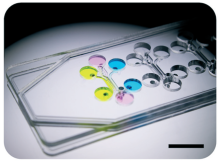BACKGROUND
Organ-on-a-chip (OOC) systems recapitulate the complex biological structures and processes that give them the potential to be more predictive of human responses during drug discovery and development. The general design of these devices falls into two categories: laterally adjacent channels in a single plane or vertically stacked single channel arrangements. As such, the structure of these devices restricts the diffusion of nutrients or flow of molecules involved in cell communication to either the lateral or the vertical direction, different from the native 3D diffusional movement found in biological tissues. To be more closely reflective of in vivo conditions, new strategies are necessary to enable multidirectional molecular flow.
TECHNOLOGY OVERVIEW
Researchers at the University of Toronto have developed an organ-on-a-chip design architecture called “TANDEM” (Transverse And Normal Diffusional Environments for Multidirectional Signaling) that allows multidirectional diffusion to and from a tissue mimetic. To illustrate the concept in its simplest form, they have constructed a four-channel system consisting of two in-plane transverse channels flanking a central “hydrogel” channel, and one out-of-plane channel situated vertically above the central channel (Fig 1). Surrounding channels can be used to deliver nutrients, collect molecular information or the top channel layer can be removed to provide direct physical access for mechanical testing. Key to the design of this OOC platform is the combination of a reversible bond with the use of multiple pairs of “phaseguides” to achieve stable fluid pinning and subsequent disassembly for analysis. This proof-of-concept TANDEM device was used to demonstrate improvements in cell viability and on-chip hydrogel characterization.
Figure1. (A) Fabricated microfluidic architecture with colored water diffusing across channels. Scalebar=8mm. (B) Illustration of diffusion processes and phaseguide pinning in channel cross-section. (C) Reversible bonding at layer interfaces which allows for exposure of the centrally contained hydrogel component for mechanical stiffness testing.
COMPETITIVE ADVANTAGE
- Improved diffusion in organ-on-a-chip devices results in:
- Increased nutritional supply
- Increased collection of secretion factors from cells
- Enhanced cell viability with device (24 hr vs 72 hrs)
- ~ 30% greater in monoculture; ~ 20% greater in coculture
- More complex alternative configurations possible, using the same core unit of geometry and tailored to end-user
- Ultra-thin 200µm base layer provides optical access for reflected light and fluorescence confocal microscopy
- Reversible bonds allow for strategic disassembly and direct access to the hydrogel compartment for mechanical testing.
APPLICATIONS
- General organ-on-a-chip platform
- Hydrogel characterization
- Diffusion studies
INTELLECTUAL PROPERTY STATUS
- Provisional Patent Application Filed (Sept 2021)
PROJECT STATUS
A sample four channel device was constructed as a proof-of-concept. Phaseguides were optimized to improve hydrogel pinning quality and repeatability. Computational transport model simulations revealed the potential for greater nutrient delivery into the hydrogel and for molecular transport out of the hydrogel. A comparison of cell viability (HUVECs and PSCs) in monoculture and coculture revealed a significant increase with the TANDEM design. On-chip mechanical testing after 7 days indicated a twofold increase in hydrogel stiffness when gel-embedded PSCs were cocultured with pancreatic tumor cells (PANC-1). Reflected light confocal microscopy showed local densification of hydrogel fibers around activated PSCs in coculture.





